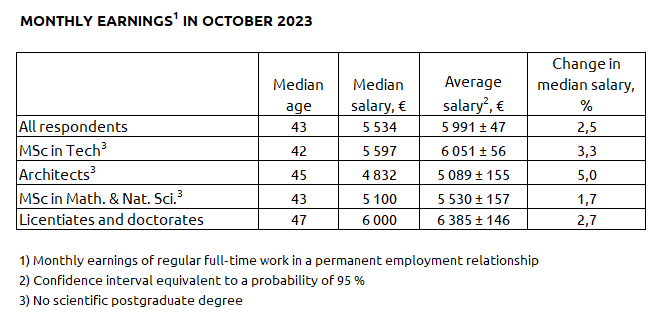
According to the TEK labour market survey, the median salary of an academic engineer (Master of Science in Engineering) in permanent employment was 5,597 euros and the average salary was 6,051 euros per month in October 2023. The corresponding salary figures for tech graduates in 2023 were 3,920 and 3,979 euros.
The median salary of an academic engineer increased by 3.3 percent from the previous year. The salary development was also positive in other degree groups.
This time the median salary of architects increased the most, by 5.0 percent. However, there is more uncertainty in the results of groups with small numbers of respondents, such as architects, and annual fluctuations in different directions are not uncommon.

Although salaries increased, the rise in prices was still slightly faster. According to Statistics Finland, the annual change in consumer prices was 4.9 percent in October.
General increase is the most common reason for a pay rise
Of the full-time employed respondents, 85 percent estimated that their salary had increased from the previous year. Nine percent said their salary had remained unchanged and three percent said their salary had decreased. The proportion of those who received a pay rise was higher than in the previous year, when 81 percent of respondents estimated that their salary had increased.
Clearly the most common reason for a pay rise was a general increase, which was reported by 77 percent of those respondents whose salary had increased.
“It seems that salaries only increase by as much as agreed in collective agreements. The merit increases voluntarily paid by employers target a rather narrow group. This tells us what benefit a trade union has. If joining a union does not interest in the future, salary earners should be prepared for the fact that the entire agreement mechanism will be removed and fewer and fewer people will get a pay rise, says Teemu Hankamäki, TEK’s labor market director.
A personal performance-based pay rise, or so-called merit increase, was received by 22 percent of respondents.
Of those who received a pay rise, 11 percent reported the reason for the increase was a new position with the same employer, and 9 percent had received a pay rise by changing jobs. Fewer than in the previous year reported the reason for the pay rise to be a change of position or job.
Changing jobs brings the biggest increases
The monthly salary of those who received a merit increase had increased by an average of 340 euros (median increase) per year. A new position or task with the same employer had brought an average of 600 euros and a transfer to a new employer an average of 750 euros increase in monthly salary.
In 2023, many sectors paid pay increases of about 3.5 percent, of which some were general increases and some were employer-paid installments. In addition, a one-off compensation was paid, which was not reflected in the October salaries. However, pay increases may also have been agreed differently locally.
There are significant salary differences between sectors
The highest median salary was in the financial and insurance sectors and in the auditing and management consulting sector. The median salary was also over 6,000 euros in the construction sector, the trade sector, the forest industry and the telecommunications sector.
The largest sectors of TEK members, i.e. the metal and engineering industry, the consulting sector and the information technology service sector, were not among the best-paid sectors.
“This tells us that different sectors have different opportunities to increase productivity and thus increase the employer’s ability to pay salaries,” Hankamäki says.
The lowest median salary was in the municipal sector, the consulting sector and the university sector. The median salary in the consulting sector and the university sector was less than 5,000 euros.
The median salary by sector chart shows the salaries of respondents by sector. It should be noted that both management and middle management respondents and experts are included. More detailed statistics for TEK members can be found on the website www.tek.fi/salary.
Industry uses performance-based pay the most
About six out of ten full-time respondents said they were covered by performance-based pay. Performance-based pay is clearly most used in industry, where almost 80 percent of respondents were covered by performance-based pay.
By position, performance-based pay is more common in management than in expert positions. Of those working in management or middle management positions, about 70 percent were covered by performance-based pay, and in expert positions just over half.
Of those covered by performance-based pay, 81 percent had received a performance bonus in the last 12 months. The proportion was roughly the same as in the 2022 labor market survey.
The average size of the performance bonus was also the same as in the previous year, eight percent of annual income (median). Relatively, the largest performance bonuses were paid in industry, where the share was nine percent. The position also affects the size of the performance bonus. In management, the median was 15 percent, in middle management 8 percent and in experts 7 percent.
How the survey was conducted
The data collection for the labour market survey was carried out in October-November 2023, and the target group was TEK members in the labour market. About 9,500 responses were received, and the response rate was about 21. There were about 400 respondents more than in the previous year, and the response rate also improved slightly.
Of the respondents, 74 percent were men and 26 percent were women. The median age was 43 years. The most common degree completed was a master’s degree in engineering, 76 percent of respondents. The majority of respondents, 90 percent, were in full-time employment. Three percent of respondents were unemployed or laid off, and the share of full-time entrepreneurs was 1.5 percent. The share of unemployed and laid off was slightly higher than in the previous year, when the share was 2.2 percent.
Of the full-time respondents, 86 percent worked in the private sector, and half of them in industry. 96 percent had a permanent employment relationship.
A big thank you once again to all those who responded to the survey!